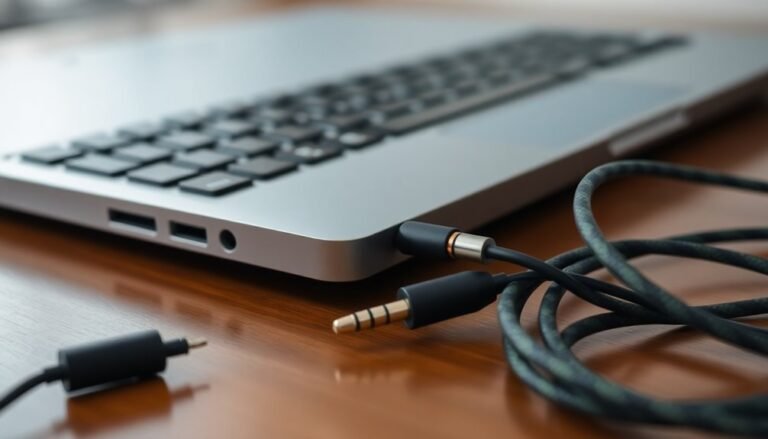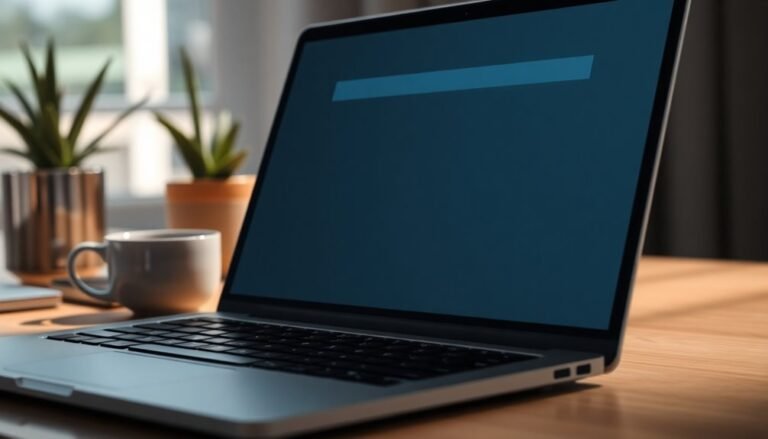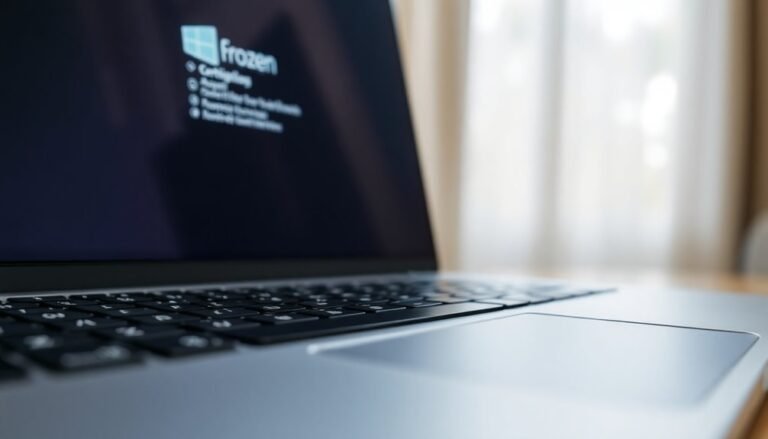Computer Running Slow Windows 10: Speed Up Your Windows 10 PC

If your Windows 10 PC is running slow, start by disabling non-essential startup programs with Task Manager. Also, turn off unnecessary background apps in Settings.
Switch off visual effects under System Properties to boost speed. Run Disk Cleanup to free up storage space.
Make sure you install the latest updates and drivers regularly. Optimize your memory by closing unused tabs or programs.
For deeper, advanced tips on managing resources and optimizing storage, there’s a lot more you can discover.
Optimize System Resource Management

Optimize System Resource Management in Windows 10 for Maximum Performance
Your PC’s hardware establishes the baseline for performance, but optimizing how Windows 10 manages system resources can significantly enhance speed and responsiveness. Windows 10 employs intelligent resource allocation techniques to dynamically assign CPU and memory based on the priority of running applications. High-demand tasks like video editing receive more CPU power, while background processes are allocated fewer resources, freeing up capacity for critical applications.
Windows 10 continuously monitors RAM usage through advanced memory compression and efficient clearing of unused memory allocations to prevent slowdowns and memory leaks.
Take advantage of Windows 10’s process prioritization features to ensure that high-priority and system-critical apps run smoothly by adjusting process importance and balancing CPU time slices effectively. Regular monitoring of resource performance trends helps users proactively manage and identify potential bottlenecks before they impact overall system speed.
The operating system also optimizes disk input/output by scheduling file read/write operations and leveraging caching mechanisms, which keeps file access fast and minimizes fragmentation.
Additionally, Windows 10’s network management prioritizes essential bandwidth needs and disables unused network adapters, ensuring efficient and responsive data flow.
Tweak Visual Effects for Better Performance
Optimize Windows 10 Performance by Tweaking Visual Effects Settings
Boost your Windows 10 PC performance by fine-tuning visual effects settings. Visual effects such as animations, transparency, and shadows enhance the Windows interface but can reduce system responsiveness, especially on older or low-powered computers. [Disabling visual effects has been widely believed to speed up Windows, but in reality, most modern systems are designed to handle these effects efficiently and gains are typically negligible.]
To improve speed and responsiveness, access these settings via Control Panel by navigating to System and Security > System > Advanced System Settings. Then, click the Advanced tab and select Performance Settings.
Choose “Adjust for best performance” to disable all visual effects, or select “Custom” to keep essential features like smooth font edges, drop shadows on icon labels, and showing window contents while dragging.
Disabling non-essential visual effects like menu animations and transparency lowers GPU usage, resulting in faster interface performance and improved battery life on laptops. Avoid turning off all effects, as some improve readability and usability.
Experiment with different visual effects combinations to find the optimal balance between system performance and visual appeal tailored to your workflow.
By tweaking Windows 10 visual effects, you can significantly enhance your PC’s speed, responsiveness, and battery efficiency.
Try these performance tips today for a smoother, faster Windows experience.
Maintain and Update Your System Regularly
How to Maintain and Update Your Windows 10 System for Optimal Performance
After optimizing visual effects to boost your Windows 10 performance, the next crucial step is to maintain and update your system regularly. Consistent system maintenance ensures long-term speed, stability, and security.
Regular updates prevent slowdowns, protect your PC from security threats, and resolve compatibility issues. Follow these essential tips to keep your Windows 10 PC running smoothly:
- Install Windows Updates Regularly: Navigate to Settings > Update & Security > Windows Update. Schedule automatic updates during idle hours and never skip them. Windows updates include critical security patches, bug fixes, and driver enhancements that improve overall system performance.
- Update Device Drivers: Access Device Manager by pressing Windows + X, then right-click your hardware components and select “Update driver.” Opt for automatic updates to download the latest drivers, minimizing hardware conflicts, system crashes, and improving device functionality.
- Clean Up Disk Space Efficiently: Use the built-in Disk Cleanup tool weekly or monthly to remove unnecessary junk files. Uninstall apps you no longer use and enable Storage Sense for automated disk space management, which helps maintain optimal system responsiveness.
- Run Regular Security Scans: Schedule monthly antivirus scans and keep your security definitions up to date. Promptly address any alerts or threats to prevent malware from slowing down your computer and compromising your data.
By following these Windows 10 maintenance and update best practices, you can ensure your PC remains fast, secure, and reliable.
Stay proactive with system care to enjoy a seamless computing experience every day.
Adjust Hardware Timers and Device Settings
Optimize Windows 10 Performance by Adjusting Hardware Timers and Device Settings
Many Windows 10 users overlook hardware timer settings, but fine-tuning these can significantly boost system performance, especially for gaming and real-time applications. One key adjustment is managing the High Precision Event Timer (HPET).
To disable HPET, open Device Manager, expand System Devices, right-click on HPET, and select “Disable.” After disabling, test your system’s gaming performance and frame rates—if you notice smoother gameplay, keep HPET disabled; if not, re-enable it for stability.
Additionally, improve input responsiveness by adjusting the Windows system timer resolution. Use tools like TimerRes to temporarily lower the timer interval to as low as 1 ms, which helps reduce input lag during gaming sessions.
Keep in mind, this setting resets after a system reboot.
For advanced optimization, access your BIOS settings to enable features like Precision Boost Overdrive and resizable BAR, which enhance CPU throughput and overall system responsiveness.
Also, review and manage CPU power-saving states, as they can affect timer behavior, particularly on Intel processors. Updating your BIOS regularly and disabling unnecessary devices or timers can reduce interrupt overhead, further improving Windows 10 performance.
By properly adjusting hardware timers and device settings, you can unlock better gaming experiences and smoother real-time application performance in Windows 10.
Follow these expert tips to maximize your PC’s responsiveness and efficiency today.
Enhance Storage and File System Efficiency

Boost Your Windows 10 Performance by Enhancing Storage and File System Efficiency
Is your Windows 10 PC running slower than usual? One common cause is inefficient storage and file system management. Proper disk usage and organized files are crucial for maintaining a fast and responsive system.
To maximize your Windows 10 performance, implement smart cleanup strategies, effective file compression, seamless cloud storage integration, and optimized disk layout. Follow these expert tips to enhance your storage and file system efficiency today:
- Clean Up Unnecessary Files in Windows 10: Use the built-in Disk Cleanup tool, regularly empty the Recycle Bin, and activate Storage Sense to automatically delete temporary files and leftover update data. Keeping your storage clean helps speed up your PC.
- Apply NTFS Compression for Better Storage Management: Compress documents and infrequently used files with NTFS compression to save disk space. For system files, consider enabling Compact OS, but avoid compressing program folders to prevent performance issues.
- Integrate OneDrive Cloud Storage for More Space: Take advantage of OneDrive Files On-Demand in Windows 10 to offload large or rarely accessed files to the cloud. This frees up valuable local storage without losing file accessibility.
- Optimize Your Disk Layout for Faster Access: Separate your system, applications, and user data by partitioning drives. Regularly run SSD trimming and HDD defragmentation tools to maintain disk health. Monitor disk usage to identify and resolve bottlenecks that slow down your system.
By following these proven methods to enhance storage and file system efficiency, you can keep your Windows 10 PC running smoothly and efficiently.
Implement these tips now for a faster, more responsive computing experience.
Manage Programs and Background Processes
Optimize Windows 10 Performance by Managing Programs and Background Processes
Windows 10 automatically handles many system tasks, but unnecessary programs and background processes can still slow down your PC. To boost your computer’s speed and efficiency, start by opening Task Manager using Ctrl+Shift+Esc. Navigate to the Startup tab and disable non-essential apps like Spotify or Steam. This reduces background activity and improves boot times, ensuring only critical security and hardware services remain enabled.
Next, head to Settings > Privacy > Background Apps and turn off apps you rarely use. This step further minimizes resource consumption and enhances overall system performance.
For advanced optimization, open services.msc and choose to hide all Microsoft services. Then, disable unwanted third-party services such as telemetry, but be sure to research each service before making changes to avoid disrupting important functions.
Additionally, use msconfig to perform a clean boot by disabling all non-Microsoft services. This helps troubleshoot performance issues and isolate resource-heavy programs. Regularly monitor the Processes tab in Task Manager to identify and end tasks that consume excessive resources.
Frequently Asked Questions
Will Upgrading My RAM Significantly Speed up My Windows 10 PC?
If you’re running out of memory during multitasking or using demanding apps, upgrading your RAM will noticeably boost speed and responsiveness. However, if you already have enough RAM, you won’t see a significant improvement.
Can a Failing Hard Drive Cause My Computer to Run Slow?
Just like a worn-out engine slows a car, a failing hard drive drags your computer’s speed down. You’ll notice slow file access, crashes, and errors. Backup your data and replace the drive to restore performance.
Does Switching to an SSD Improve Windows 10 Performance?
Yes, you’ll notice a dramatic boost in Windows 10 performance when you switch to an SSD. Your system boots faster, programs launch quicker, and overall responsiveness improves because SSDs offer much higher read/write speeds and reliability.
How Does Overheating Affect My Computer’s Speed?
Overheating can turn your computer into a sluggish, unreliable mess. You’ll notice slower speeds, random crashes, and loud fans. Act fast—clean out dust, improve airflow, and check cooling systems to restore performance and prevent damage.
Will Reinstalling Windows 10 Make My PC Faster?
Yes, reinstalling Windows 10 can make your PC feel faster by removing clutter, malware, and unnecessary apps. You’ll notice smoother performance, but don’t expect major boosts in gaming or demanding tasks unless you upgrade your hardware.
Conclusion
Imagine your PC booting in under 20 seconds, apps launching instantly, and zero lag during video calls. That’s what happened when Sarah, a graphic designer, tackled her sluggish Windows 10 using these exact tips. Now it’s your turn—optimize resources, adjust settings, and keep your system updated. You’ll notice faster performance, improved reliability, and a smoother workflow. Don’t settle for slow speeds—take control and experience what your Windows 10 PC is truly capable of.





